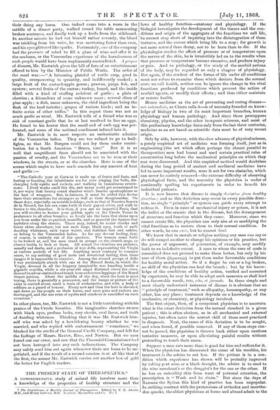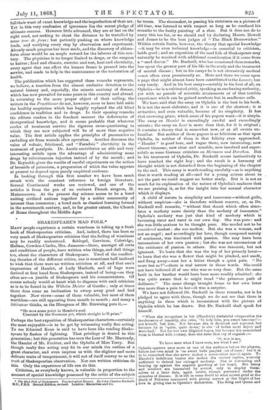THE PRESENT STATE OF THERAPEUTICS.*
A COMPREUENSIVE study of animal life involves more than a knowledge of the properties of healthy structure and time • The Practitioner, a Monthly Journal of Therapeutics. Edited by F. E. Anatie, 1LD., and Henry Lawson, M.D. London: Macmillan and Co. No. 1
laws of healthy function—anatomy and physiology. If the biologist investigates the development of the tissues and the con- ditions and origin of the aggregate of the functions we call life, he cannot stop short of inquiring into the disintegration of these textures, and the causes which bring life to a stop ; for growth is not more natural than decay, nor to be born than to die. If the physiologist studies the effect of pressure or of temperature upon the nerves of the skin, he is irresistibly led on to the results when that pressure or temperature become excessive, and produce injury or pain. And so pathology, or the study of the morbid actions of the body, may be regarded as only a chapter of physiology. But again, if the student of the forms of life under all conditions must not refuse to examine those which deviate from the normal state we call health, neither can he ignore the change in the vital functions produced by conditions which prevent the action of morbid agents, or modify their effects ; and thus either maintain or restore health.
Hence medicine as the art of preventing and curing disease- ars valetudinis, as Cicero calls it—is of necessity founded on know- ledge of biology in two of its most important branches, human physiology and human pathology. And since these presuppose chemistry, physics, and the other inorganic sciences, and most of this preliminary knowledge dates only from the last three centuries, medicine as an art based on scientific data must be of very recent origin.
Side by side, however, with the slow advance of physical science, a purely empirical art of medicine was forming itself, just as in engineering (the art which offers perhaps the closest parallel to therapeutics) men had learnt and used certain practical rules of construction long before the mechanical principles on which they rest were discovered. And this empirical method would doubtless during the long period of ancient and mediaeval medicine have led to more important results, were it not for two obstacles, which can never be entirely removed—the extreme difficulty of observing physiological facts, and the necessity the physician is under of continually spoiling his experiments in order to benefit his individual patients.
It is now known that disease is simply deviation front healthy function ; and as this deviation may occur in every possible direc- tion, no single " principle " or system can guide every attempt to redress it. Even in cases of mechanical injury or poison, it is not the bullet or the arsenic that is the disease, but the derangement of structure and function which they cause. Moreover, since We cannot create life, the physician can only aim at so modifying the vital functions as to restore them to their normal condition. In other words, he can cure, but he cannot heal.
We kuow that in morals or religion nothing any man can say or do will compel another to change his opinions or his practice, but the power of argument, of persuasion, of example, may modify both to an indefinite extent. A man to whom the cure of souls is committed does not pretend to make them better, but only by his care of them (0.EpalrEia) to put them under favourable conditions for healthy moral action. So if a finger be cut or a leg broken, uo skill of the physician can heal the breach ; but by his know- ledge of the conditions of healthy action, verified and corrected by experience, be may be able to adopt such measures as shall lead to a favourable result, tato, city, et jaeunde. In these simple and most clearly understood instances of disease it is obvious that no " principle of treatment," such as allopathy, homoeopathy, or any other, has any place ; treatment depends on a knowledge of the mechanics, or chemistry, or physiology involved.
The first object, then, of a competent physician is to ascertain what is the exact deviation from the normal standard in a given patient ; this is often obvious, as in all mechanical and external injuries, but often taxes the acutest skill of those most practised in diagnosis. Next, the cause of this deviation is to be sought, and when found, if possible removed. If any of these steps can- not be passed, the physician is thrown back either upon cautious tentative measures, or upon alleviating painful results without pretending to touch their cause.
Suppose a man eats snore than is good for him and suffers for it. When the physician has discovered the cause of his troubles, his treatment is the advice to eat less. If the patient is in a con- dition which experience has shown will be probably improved by taking port wine or a black draught, the advice is to send to the wine merchant's or the druggist's for the one or the other. If he has an unhealthy skin from want of personal attention, the prescription is " Wash and be clean." But since the days of Naaman the Syrian this kind of practice has been unpopular. In striking contrast with the pretensions of orthodox and unortho- dox quacks, the ablest physicians at home and abroad admit to the full their want of exact knowledge and the imperfection of their art. Yet in this very confession of ignorance lies the surest pledge of ultimate success. However little advanced, they are at last on the right road, not seeking to cheat the distance to be travelled by some tour de force; but patiently pushing on where knowledge leads, and verifying every step by observation and experiment. Already much progress has been made, and the discovery of chloro- form alone would be an ample reward for the labours of this cen- tury. The physician is no longer limited to drugs, or the surgeon to knives ; food and climate, exercise and rest, heat and electricity, every agent that can affect the human frame is pressed into the service, and made to help in the maintenance or the restoration of health.
The publication which has suggested these remarks represents, we believe, a reaction from the almost exclusive devotion to the natural history and, especially, the minute anatomy of disease, which has now prevailed for some years in this country and abroad. In returning to the more proper object of their calling, the writers in the Practitioner do not, however, seem to have laid aside the healthy scepticism which has happily replaced the old blind confidence in tradition and in drugs. In their opening remarks the editors confess in the frankest manner the deficiencies of therapeutical knowledge, and it seems probable that whatever modes of treatment survive the rigorous cross-questioning to which they are now subjected will be of more than negative value. The first article applies the principles of pneumatics to excluding air from wounds after operation. Another discusses the value of voltaic, frictional, and " Faradaic " electricity in the treatment of paralysis. Dr. Anstie contributes an able and very interesting article upon the advantage of administering some drugs by subcutaneous injection instead of by the mouth ; and Dr. Reynolds gives the results of careful experiments on the action of bromide of potassium, a preparation of which the value appears at present to depend upon purely empirical evidence.
In looking through this first number we have been much struck with the constant reference to foreign literature. Several Continental works are reviewed, and one of the articles is from the pen of an eminent French surgeon, M. Maisonneuve. At the present day science seems to be a bond uniting civilized nations together by a nobler community of interest than commerce ; a bond such as classical learning formed in the seventeenth century, and, to far greater extent, the Church of Rome throughout the Middle Ages.































 Previous page
Previous page